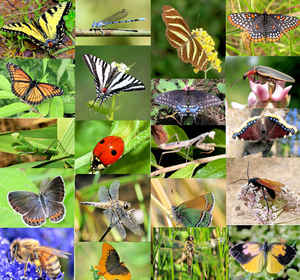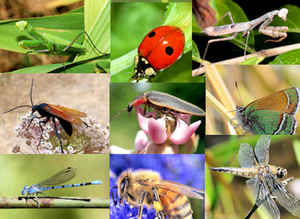
Utah Symbols
Utah State Insect
Honey Bee

(Apis mellifera)
Adopted on March 16, 1983.
The Honey Bee, (Apis mellifera,) was adopted on March 16,1983.
The bill was introduced by Sen. Fred W. Finlinson because of the lobbying effort of the fifth grade class of Ridgecrest Elementary School in Salt Lake County as part of a class study project on the insect and on how state government works. The honey bee is significant in Utah history, as Utah was first called by its Mormon settlers, "The Provisional State of Deseret," a Book of Mormon word meaning honey bee.
Did you know that: The honey bee
has been proclaimed the official state insect in each of the following states:
Arkansas | Georgia | Kansas
| Kentucky | Louisiana
Maine | Mississippi |
Missouri | Nebraska | New Jersey
North Carolina | Oklahoma | South
Dakota | Tennessee
Utah | Vermont | West Virginia
| Wisconsin
Utah State Insect: Honeybee

The honey bee is significant in Utah history, as Utah was first called by its Mormon settlers "The Provisional state of Deseret," a name derived from the Book of Mormon word meaning honey bee. When Utah became a territory in 1850, the Mormons were unsuccessful in their attempt to have the name "Deseret" retained.
The new millennium brings a new agricultural and health threat to Southern Utah as the Africanized Honey Bee (killer bee) has been discovered within 30 miles of the Utah border. The Nevada Department of Agriculture reports that tests conducted on bees collected after a stinging incident in Mesquite, Nevada showed the bees to be Africanized Honey Bees.
Honey bees are not native to the Americas, but were brought to the Americas by European settlers during the 1600s. This type of honey bee, which is the one that is now common in Utah, is the European Honey Bee. The Africanized Honey Bee was brought to Brazil and cross-bred with European Honey Bees so that they could better tolerate the hot tropical climate in South America. Several of these Africanized colonies escaped, swarmed into the Brazilian jungle and interbred with local European colonies. Over the past 40 years, these colonies have been spreading northward, arriving in the United States in 1990.
European Honey Bee
This "social" insect, which grows and lives in highly organized colonies, is important to Vermont farmers and orchardists by being a principal pollinator of certain of their crops. But it is best know, of course, for the pleasant-tasting and healthful honey which it produces. Though they represent a relatively small part of the state's agricultural economy, Vermont beekeepers generally produce several hundred thousand pounds of honey each year.
Bees produce honey as food stores for the hive during the long months of winter when flowers aren't blooming and therefore little or no nectar is available to them. European honey bees, genus Apis Mellifera, produce such an abundance of honey, far more than the hive can eat, that humans can harvest the excess. For this reason, European honey bees can be found in beekeeper's hives around the world!
Honeybees probably originated in Tropical Africa and spread from South Africa to Northern Europe and East into India and China. They were brought to the Americas with the first colonists and are now distributed world-wide. The first bees appear in the fossil record in deposits dating about 40 million years ago in the Eocene. At about 30 million years before present they appear to have developed social behavior and structurally are virtually identical with modern bees.
Characteristics of the Utah Honeybee
Colony:
Honey bees are social insects, with a marked division of labor between the various types of bees in the colony. A colony of honey bees includes a queen, drones and workers.
The Queen:
The queen is the only sexually developed female in the hive. She is the largest bee in the colony.
A two-day-old larva is selected by the workers to be reared as the queen. She will emerge from her cell 11 days later to mate in flight with approximately
18 drone (male) bees. During this mating, she receives several million sperm cells, which last her entire life span of nearly two years.
The queen starts to lay eggs about 10 days after mating. A productive queen can lay 3,000 eggs in a single day.
The Drones:
Drones are stout male bees that have no stingers. Drones do not collect food or pollen from flowers. Their sole purpose is to mate with the queen. If the colony is short on food, drones are often kicked out of the hive.
The Workers:
Workers, the smallest bees in the colony, are sexually undeveloped females. A colony can have 50,000 to 60,000 workers.
The life span of a worker bee varies according to the time of year. Her life expectancy is approximately 28 to 35 days. Workers that are reared in
September and October, however, can live through the winter.
Workers feed the queen and larvae, guard the hive entrance and help to keep the hive cool by fanning their wings. Worker bees also collect nectar to
make honey. In addition, honey bees produce wax comb. The comb is composed of hexagonal cells which have walls that are only 2/1000 inch thick, but
support 25 times their own weight.
Honey bees' wings stroke 11,400 times per minute, thus making their distinctive buzz.
Utah Law
The law designating the honeybee as the official Utah state insect is found in the Utah Statutes, Title 63, Chapter 13, Section 63-13-5.5 (18).
TITLE 63. State Affairs in General.
CHAPTER 13. Miscellaneous Provisions.
SECTION 63-13-5.5. State Symbols.
63-13-5.5. State symbols.
(1) Utah's state animal is the elk.
(2) Utah's state bird is the sea gull.
(3) Utah's state centennial astronomical symbol is the Beehive Cluster located in the constellation of Cancer the Crab.
(4) Utah's state centennial star is Dubhe, one of the seven bright stars composing the Big Dipper in the constellation Ursa Major.
(5) Utah's state centennial tartan, which honors the first Scots known to have been in Utah and those Utahns of Scottish heritage, shall have a pattern
or repeating-half-sett of white-2, blue-6, red-6, blue-4, red-6, green-18, red-6, and white-4 to represent the tartan worn anciently by the Logan and
Skene clans, with the addition of a white stripe.
(6) Utah's state cooking pot is the dutch oven.
(7) Utah's state emblem is the beehive.
(8) Utah's state fish is the Bonneville cutthroat trout.
(9) Utah's state flower is the sego lily.
(10) Utah's state folk dance is the square dance, the folk dance that is called, cued, or prompted to the dancers and includes squares, rounds, clogging,
contra, line, and heritage dances.
(11) Utah's state fossil is the Allosaurus.
(12) Utah's state fruit is the cherry.
(13) Utah's state vegetable is the Spanish sweet onion.
(14) Utah's historic state vegetable is the sugar beet.
(15) Utah's state gem is topaz, as is prominently found in the Thomas Mountain Range in Juab County, Utah.
(16) Utah's state grass is Indian rice grass.
(17) Utah's state hymn is "Utah We Love Thee" by Evan Stephens.
(18) Utah's state insect is the honeybee.
(19) Utah's state mineral is copper.
(20) Utah's state motto is "Industry."
(21) Utah's state railroad museum is Ogden Union Station.
(22) Utah's state rock is coal.
(23) Utah's state song is "Utah This is the Place" by Sam and Gary Francis.
(24) Utah's state tree is the blue spruce.
Taxonomic Hierarchy: Western Honey Bee
Kingdom: Animalia (Animals)
Phylum: Arthropoda (Arthropods)
Subphylum: Hexapoda (Hexapods)
Class: Insecta (Insects)
Order: Hymenoptera (Ants, Bees, Wasps and Sawflies)
No Taxon: (Aculeata - Ants, Bees and Stinging Wasps)
No Taxon: (Anthophila (Apoidea) - Bees)
Family: Apidae (Cuckoo, Carpenter, Digger, Bumble, and Honey Bees)
Subfamily: Apinae (Honey, Bumble, Long-horned, Orchid, and Digger Bees)
Tribe: Apini (Honey Bees)
Genus; Apis
Species: mellifera (Western Honey Bee)
Butterflies, and Bugs







